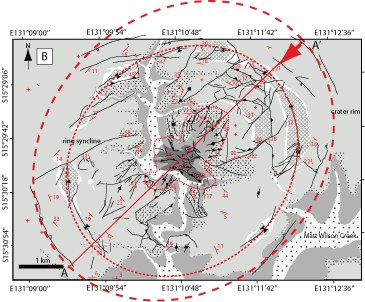Underground Structure of oblique-angled Impact Craters
Underground structure of oblique-angled impact craters
Matt Wilson Impact crater, Australia.
Click on picture to see entire image.
Dr. Michael Poelchau
Prof. Dr. Thomas Kenkmann
Sponsoring: DFG KE 732/11-1
Term: 2006-2009
Abstract
Almost all impact craters on Earth are circular. About 4% however might have been developed by oblique angled impacts of 12° or less (measured from the horizon). These impacts have formed elongated, elliptic crater shapes. So far the forming processes of elliptic craters have not been analyzed efficiently.
The proterozoic Matt Wilson Crater in Australia is the first known elliptic crater on Earth, containing a central mountain. Because of the central mountain it is possible to study the mechanics of crater formations at a critical impact angle of 10 – 15°. Matt Wilson's axis ratio is 1.2 . The diameters are 7.5 and 6.3 km. The axis follows a NE-SW direction.
Field examinations in July 2007 revealed in the basis of the crater, which has been excavated after erosion, a central mountain with a favorite stacking of overlapping beds. This stacking indicates NE-SW shortening and transport of materials “ top-to-SW”. This sense of movement proceeds in the direction of the impact("downrange") and is presumably caused by transmission of the horizontal impulse of the projectile hitting the surface. Consequently we have indications for the significance of structural asymmetries as indicator for the impact direction of the projectile.
The effects of oblique angled impacts have also been analyzed at simple craters like Wolfe Creek, Australia, and Meteor Crater, AZ, USA.
Publications
KENKMANN, T. AND POELCHAU, M. H. (2009). Low-angle collision with Earth: the elliptical impact crater Matt Wilson, NT, Australia. Geology 37, 5, 459–462; doi: 10.1130/G25378A.1
POELCHAU, M. H., KENKMANN, T, AND KRING, D. A. (2009). Rim uplift in simple craters: the effects of target heterogeneities and trajectory obliquity. Journal of Geophysical Research, 114, E01006; doi: 10.1029/2008JE003235.
POELCHAU, M. AND KENKMANN, T. (2008). Asymmetric signatures in simple craters as an indicator for an oblique impact vector. Meteoritics and Planetary Science, 43, 12, 2059-2072

